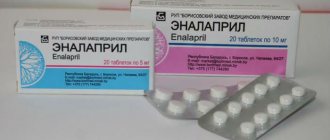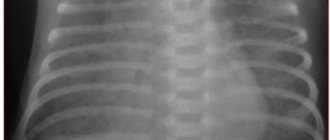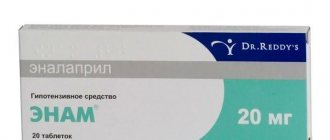Vasorenal hypertension (also vasorenal arterial hypertension , renovascular hypertension ) is a fairly common syndrome of high blood pressure among all age groups of both sexes, caused in most cases by disturbances of normal blood flow in the renal arteries (renal ischemia).
The processes of arterial stenosis due to atherosclerosis or fibromuscular dysplasia, arteriovenous fistulas, nonspecific aortoarteritis, thromboembolism and other diseases, complicating the normal flow of blood through the renal arteries, prevent the enzyme renin, secreted by the kidneys, from entering the arteries. This enzyme is responsible for regulating blood pressure; a decrease in its amount in the blood leads to hypertension.
Caused by hereditary or acquired arterial diseases, renovascular hypertension is usually very resistant to the effects of drugs and is usually permanent. Based on this collective characteristic, it can be distinguished from other types of arterial hypertension (high blood pressure).
1
Ultrasound in MedicCity
2 Consultation with a phlebologist in MedicCity
3 Vascular surgery in MedicCity
Regular examination by a phlebologist or vascular surgeon will help you avoid serious complications if vascular pathology is detected. Delay in treating vascular diseases is life-threatening! Trust your health to the MedicCity professionals!
Arterial hypertension
Symptomatic arterial hypertension is a secondary hypertensive condition that develops as a result of pathology of the organs that regulate blood pressure. Symptomatic arterial hypertension is distinguished by its persistent course and resistance to antihypertensive therapy, the development of pronounced changes in target organs (heart and kidney failure, hypertensive encephalopathy, etc.). Determining the causes of arterial hypertension requires ultrasound, angiography, CT, MRI (kidneys, adrenal glands, heart, brain), studies of biochemical parameters and blood hormones, and blood pressure monitoring. Treatment consists of medication or surgery to address the underlying cause.
Diagnosis of renal hypertension
For differentiated diagnosis of hypertension, the Clinic of Modern Medicine uses a wide range of laboratory and instrumental studies:
- blood tests, urine tests (general, biochemical, Nechiporenko, Reberg, Zimnitsky test, bacterioscopy of urinary sediment);
- excretory urography;
- Ultrasound scanning of the kidneys with Doppler sonography;
- renal arteriography;
- radioisotope renography;
- kidney biopsy.
Diagnosis of the disease is based on a comprehensive examination of the patient, aimed at identifying lesions of the renal tissues and blood vessels and establishing the etiology of the disease.
Arterial hypertension
Unlike independent essential (primary) hypertension, secondary arterial hypertension serves as symptoms of the diseases that cause them. Arterial hypertension syndrome accompanies the course of over 50 diseases. Among the total number of hypertensive conditions, the proportion of symptomatic arterial hypertension is about 10%. The course of symptomatic arterial hypertension is characterized by signs that allow them to be differentiated from essential hypertension (hypertension):
- The age of patients is up to 20 years and over 60 years;
- Sudden development of arterial hypertension with persistently high blood pressure levels;
- Malignant, rapidly progressing course;
- Development of sympathoadrenal crises;
- A history of etiological diseases;
- Poor response to standard therapy;
- Increased diastolic pressure in renal arterial hypertension.
Treatment of renal hypertension
The main efforts in the treatment of hypertension are aimed at normalizing blood pressure with simultaneous pathogenetic therapy of the underlying disease. Treatment of renal hypertension is continuous, long-term and requires mandatory adherence to a diet that limits the consumption of salt, animal proteins, spices, smoked meats and other foods that irritate the kidneys.
During therapy, the severity of renal failure is regularly assessed. Since the nature of the therapeutic techniques used depends on the underlying primary disease, treatment of renal hypertension requires only an individual approach. It is extremely important to begin adequate treatment immediately after confirmation of the diagnosis, since nephrogenic arterial hypertension tends to develop rapidly and cause irreversible changes in the structures of the kidneys.
Very often, conservative treatment methods turn out to be ineffective, so invasive and surgical measures are a priority: balloon angioplasty, vascular stenting. In the most severe cases, and only for unconditional indications, they resort to nephrectomy (removal of the damaged kidney). Nephrogenic hypertension in the presence of damage to both kidneys has the most unfavorable prognosis and requires organ transplantation.
Our medical center provides the widest range of services. You can always contact us regarding the treatment of nephrological diseases. We are ready to provide you with ] treatment of tubulointerstitial nephritis[/anchor] and treatment of tubulopathy.
Classification of symptomatic arterial hypertension
According to the primary etiological link, symptomatic arterial hypertension is divided into:
- Neurogenic (caused by diseases and lesions of the central nervous system):
- central (traumas, brain tumors, meningitis, encephalitis, stroke, etc.)
- peripheral (polyneuropathies)
- Nephrogenic (renal):
- interstitial and parenchymal (chronic pyelonephritis, glomerulonephritis, amyloidosis, nephrosclerosis, hydronephrosis, systemic lupus erythematosus, polycystic disease)
- renovascular (atherosclerosis, renal vascular dysplasia, vasculitis, thrombosis, renal artery aneurysms, tumors compressing the renal vessels)
- mixed (nephroptosis, congenital anomalies of the kidneys and blood vessels)
- renoprinic (condition after kidney removal)
- Endocrine:
- adrenal (pheochromocytoma, Conn's syndrome, adrenal hyperplasia)
- thyroid (hypothyroidism, thyrotoxicosis) and parathyroid
- pituitary (acromegaly, Itsenko-Cushing's disease)
- menopausal
- Hemodynamic (caused by damage to the great vessels and heart):
- aortosclerosis
- stenosis of the vertebrobasilar and carotid arteries
- caorctation of the aorta
- aortic valve insufficiency
- Dosage forms when taking mineralo- and glucocorticoids, progesterone- and estrogen-containing contraceptives, levothyroxine, heavy metal salts, indomethacin, licorice powder, etc.
Depending on the magnitude and persistence of blood pressure, the severity of left ventricular hypertrophy, and the nature of changes in the fundus, 4 forms of symptomatic arterial hypertension are distinguished: transient, labile, stable and malignant.
Transient arterial hypertension is characterized by an unstable increase in blood pressure, changes in the fundus vessels are absent, and left ventricular hypertrophy is practically undetectable. With labile arterial hypertension, there is a moderate and unstable increase in blood pressure that does not decrease on its own. There is mild hypertrophy of the left ventricle and narrowing of retinal vessels.
Stable arterial hypertension is characterized by persistent and high blood pressure, myocardial hypertrophy and pronounced vascular changes in the fundus (angioretinopathy I - II degrees). Malignant arterial hypertension is distinguished by sharply increased and stable blood pressure (especially diastolic > 120-130 mm Hg), sudden onset, rapid development, and the risk of severe vascular complications from the heart, brain, and fundus, which determine an unfavorable prognosis.
Symptoms
Since the development of renal hypertension is associated with various damage to the tissues and blood vessels of the kidneys, the clinical picture is directly combined with the underlying disease. The most common complaints with hypertension are:
- dysuric manifestations,
- short-term increase in temperature,
- lower back pain,
- polyuria,
- increased fatigue,
- the appearance of edema,
- general weakness.
The degree of explicitness of symptoms is determined by the stage of the disease and the presence of additional complications. Instrumental studies record a decrease in the size of the affected kidney, a decrease in blood flow in the vessels and other destructive changes.
A characteristic symptom of hypertension is a stable increase in diastolic pressure. In some cases, hypertensive syndrome acquires a malignant course, in which there is spasm of arterioles and a significant increase in peripheral vascular resistance. In the initial stage of development, renal hypertension is treatable, but as the disease progresses further, it becomes persistently resistant to treatment.
Forms of symptomatic arterial hypertension
Nephrogenic parenchymal arterial hypertension
Most often, symptomatic arterial hypertension is of nephrogenic (renal) origin and is observed in acute and chronic glomerulonephritis, chronic pyelonephritis, polycystic and hypoplastic kidneys, gouty and diabetic nephropathy, trauma and kidney tuberculosis, amyloidosis, SLE, tumors, nephrolithiasis.
The initial stages of these diseases usually occur without arterial hypertension. Hypertension develops with severe damage to the tissue or apparatus of the kidneys. The features of renal arterial hypertension are predominantly the young age of patients, the absence of cerebral and coronary complications, the development of chronic renal failure, and the malignant nature of the course (in chronic pyelonephritis - in 12.2%, chronic glomerulonephritis - in 11.5% of cases).
In the diagnosis of parenchymal renal hypertension, ultrasound of the kidneys, urine examination are used (proteinuria, hematuria, cylindruria, pyuria, hyposthenuria - low specific gravity of urine), determination of creatinine and urea in the blood (azotemia is detected). To study the secretory-excretory function of the kidneys, isotope renography and urography are performed; additionally - angiography, ultrasound of renal vessels, MRI and CT of the kidneys, kidney biopsy.
Nephrogenic renovascular (vasorenal) arterial hypertension
Renovascular or vasorenal arterial hypertension develops as a result of unilateral or bilateral disturbances of arterial renal blood flow. In 2/3 of patients, the cause of renovascular arterial hypertension is atherosclerotic damage to the renal arteries. Hypertension develops when the lumen of the renal artery narrows by 70% or more. Systolic blood pressure is always above 160 mm Hg, diastolic blood pressure is always above 100 mm Hg.
Renovascular arterial hypertension is characterized by a sudden onset or sharp worsening of the course, insensitivity to drug therapy, and a high proportion of malignant course (in 25% of patients).
Diagnostic signs of vasorenal arterial hypertension are: systolic murmurs over the projection of the renal artery, determined by ultrasonography and urography - a decrease in one kidney, a slowdown in the removal of contrast. Ultrasound shows echoscopic signs of asymmetry in the shape and size of the kidneys, exceeding 1.5 cm. Angiography reveals a concentric narrowing of the affected renal artery. Duplex ultrasound scanning of the renal arteries determines a violation of the main renal blood flow.
In the absence of treatment for renovascular arterial hypertension, the 5-year survival rate of patients is about 30%. The most common causes of death in patients: cerebral strokes, myocardial infarction, acute renal failure. In the treatment of vasorenal arterial hypertension, both drug therapy and surgical techniques are used: angioplasty, stenting, traditional operations.
With significant stenosis, long-term use of drug therapy is unjustified. Drug therapy produces a short-term and inconsistent effect. The main treatment is surgical or endovascular. For vasorenal arterial hypertension, an intravascular stent is installed to expand the lumen of the renal artery and prevent its narrowing; balloon dilatation of a narrowed section of a vessel; reconstructive interventions on the renal artery: resection with anastomosis, prosthetics, vascular bypass anastomoses.
Pheochromocytoma
Pheochromocytoma, a hormone-producing tumor that develops from chromaffin cells of the adrenal medulla, accounts for 0.2% to 0.4% of all occurring forms of symptomatic arterial hypertension. Pheochromocytomas secrete catecholamines: norepinephrine, adrenaline, dopamine. Their course is accompanied by arterial hypertension, with periodically developing hypertensive crises. In addition to hypertension, pheochromocytomas cause severe headaches, increased sweating and palpitations.
Pheochromocytoma is diagnosed when an increased content of catecholamines is detected in the urine by performing diagnostic pharmacological tests (tests with histamine, tyramine, glucagon, clonidine, etc.). Ultrasound, MRI or CT scan of the adrenal glands allows you to clarify the location of the tumor. By performing a radioisotope scan of the adrenal glands, it is possible to determine the hormonal activity of pheochromocytoma, identify tumors of extra-adrenal localization, and metastases.
Pheochromocytomas are treated exclusively with surgery; before surgery, arterial hypertension is corrected with α- or β-adrenergic blockers.
Primary aldosteronism
Arterial hypertension in Conn's syndrome or primary hyperaldosteronism is caused by an aldosterone-producing adenoma of the adrenal cortex. Aldosterone promotes the redistribution of K and Na ions in cells, fluid retention in the body and the development of hypokalemia and arterial hypertension.
Hypertension is practically not amenable to drug correction; attacks of myasthenia gravis, convulsions, paresthesia, thirst, and nictruria are noted. Hypertensive crises with the development of acute left ventricular failure (cardiac asthma, pulmonary edema), stroke, and hypokalemic cardiac paralysis are possible.
Diagnosis of primary aldosteronism is based on determining plasma levels of aldosterone and electrolytes (potassium, chlorine, sodium). There is a high concentration of aldosterone in the blood and high excretion in the urine, metabolic alkalosis (blood pH - 7.46-7.60), hypokalemia (<3 mmol/l), hypochloremia, hypernatremia. When examining blood from the adrenal veins, a 2-3-fold increase in the level of aldosterone on the affected side is detected. Radioisotope studies and ultrasound scanning of the adrenal glands reveal an enlargement of the adrenal gland affected by aldosteroma or bilateral hyperplasia of the adrenal cortex.
For malignant arterial hypertension caused by aldosteroma, surgical treatment is performed to normalize or significantly reduce blood pressure in 50-70% of patients. Before surgery, a hyposodium diet is prescribed and treatment with an aldosterone antagonist, spironolactone, which relieves hypokalemia and arterial hypertension (25-100 mg every 8 hours).
Itsenko-Cushing's syndrome and disease
Endocrine arterial hypertension develops in 80% of patients with the disease and Cushing's syndrome. Hypertension is caused by hypersecretion of glucocorticoid hormones by the adrenal cortex (hypercortisolism) and is characterized by a stable, crisis-free course, resistance to antihypertensive therapy, and a proportional increase in systolic and diastolic blood pressure. Another characteristic manifestation of the disease is Cushingoid obesity.
With Itsenko-Cushing's syndrome/disease, the level of 11 and 17-OCS, corticotropin, and hydrocortisone increases in the blood. Excretion of 17-KS and 17-OX is increased in urine. For differential diagnosis between corticosteroma and pituitary adenoma, MRI and CT scanning of the adrenal glands, pituitary gland, ultrasound and radioisotope scanning of the adrenal glands, and a craniogram are performed. Treatment of hypercortisolism and the arterial hypertension caused by it can be medication, surgery or radiation.
Coarctation of the aorta
Coarctation of the aorta is a congenital malformation of the aorta, manifested by its segmental narrowing, which impedes systemic blood flow. Coarctation of the aorta is a rare form of hypertension.
With secondary arterial hypertension caused by coarctation of the aorta, there is a difference in blood pressure measured in the arms (high) and legs (normal or low), an increase in blood pressure at the age of 1-5 years and its stabilization after 15 years, weakening or absence of pulsation in the femoral arteries , increased cardiac impulse, systolic murmurs over the apex, base of the heart, and on the carotid arteries. Diagnosis of coarctation of the aorta is based on radiography of the lungs and chest organs, aortography, and echocardiography. If the degree of stenosis is severe, surgical treatment is performed.
Dosage forms of arterial hypertension
The development of medicinal forms of arterial hypertension can cause vascular spasm, increased blood viscosity, sodium and water retention, the effect of drugs on the renin-angiotensin system, etc. Intranasal drops and cold remedies containing adrenomimetics and sympathomimetics in their composition (pseudoephedrine, ephedrine , phenylephrine) may cause hypertension.
Taking non-steroidal anti-inflammatory drugs causes the development of arterial hypertension due to fluid retention and suppression of the synthesis of prostaglandins, which have a vasodilating effect. Oral contraceptives containing estrogens have a stimulating effect on the renin-angiotensin system and cause fluid retention. Secondary arterial hypertension develops in 5% of women using oral contraception.
The stimulating effect of tricyclic antidepressants on the sympathetic nervous system can cause the development of arterial hypertension. The use of glucocorticoids increases blood pressure due to increased vascular reactivity to angiotensin II.
To establish the cause and form of secondary arterial hypertension, the cardiologist needs a detailed collection of the patient’s medical history, analysis of the coagulogram, and determination of blood renin.
Neurogenic arterial hypertension
Arterial hypertension of the neurogenic type is caused by lesions of the brain or spinal cord due to encephalitis, tumors, ischemia, traumatic brain injury, etc. In addition to increased blood pressure, they are typically characterized by severe headaches and dizziness, tachycardia, sweating, salivation, vasomotor skin reactions, abdominal pain, nystagmus, convulsive seizures.
Diagnostics use angiography of cerebral vessels, CT and MRI of the brain, and EEG. Treatment of arterial hypertension of the neurogenic type is aimed at eliminating brain pathology.
Causes of renal hypertension
The development of hypertension is based on various mechanisms, the main ones being:
- retention of water and sodium ions,
- suppression of renal depressor systems,
- activation of the angiosin-renin-aldosterone system.
The triggering factor for the occurrence of hypertension is a decrease in glomerular filtration and renal blood flow due to diffuse damage to the renal parenchyma and blood vessels that occurs against the background of such diseases:
- chronic pyelonephritis,
- polycystic kidney disease,
- congenital developmental anomalies,
- diabetic glomerulosclerosis,
- kidney tuberculosis,
- chronic glomerulonephritis,
- diffuse connective tissue lesions.
Also, atherosclerosis of the renal vessels, mechanical compression of the renal vessels by a tumor, cyst or adhesions, and vascular damage due to nephroptosis can lead to the development of renal hypertension. Damage to the parenchyma and blood vessels gradually depletes the compensatory capabilities of the kidneys, as a result of which they can no longer perform their functions as a blood pressure regulator.








